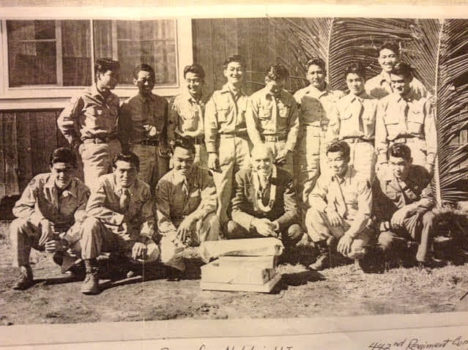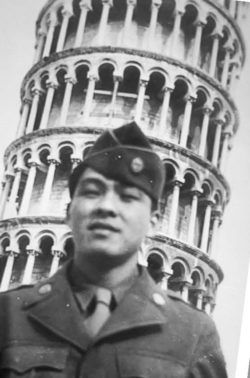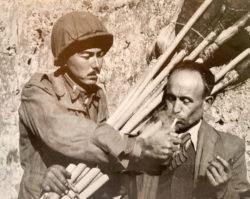Passing of a Generation: The Last of Molokai’s 442 Veterans
By Jack Kiyonaga, Reporter

Photo courtesy of Phillip Kikukawa.
With the recent passing of Robert Goro Uemura, a chapter has eclipsed. It is believed that Uemura was the last living member of the 442nd Regimental Combat Team from Molokai.
The 442nd Regimental Combat Team was formed in 1943 and comprised of Nisei, or second generation Japanese Americans, during World War II. After the bombing of Pearl Harbor by the Japanese on Dec. 7, 1941, Japanese Americans were subjected to Executive Order 9066, declaring people of Japanese ancestry as threats to the state. This resulted in the loss of civil rights and, in certain areas, internment. Despite this degradation of liberty, when the call went out to form an all Japanese American unit in 1943 — the military still being segregated at the time — thousands of Nisei, mostly from Hawaii, volunteered.
The 442 fought in Italy and France, helping to free Europe from Nazi control. Among their accomplishments were saving the lost Texas Battalion and liberating the Dachau concentration camp. They became famous for their gutsy fighting, heavy casualties, and unit motto, familiar to many: “Go For Broke.”
As a result, the 442 is the most decorated military unit in American history, receiving 4,000 Purple Hearts, 21 Medals of Honor and seven Presidential Unit Citations.
The names of the 442 are well known in Hawaii. They include Senators Daniel Inouye and Spark Matsunaga. They also include Molokai’s own Art and Bert Kikukawa, Donald Shimizu, Ed and William Okawaki, Wataru and Goro Uemura, Kazumasa Araki, Masato and Masami Takata, Toku Okimoto, Albert Tamura, Akiso Tengan, Seichi, Susumu and Masao Sakaida, Kiyotoshi Mitsui, Robert Takeo and Joseph Kiyonaga.

Robert Goro Uemura. Photo courtesy of Tracy Uemura.
These Molokai members of the 442 came home from war and continued with their lives. Some left Molokai, some stayed. Many of them had previously worked for California Packing Company and picked back up with their jobs there. Others established well known businesses on Molokai like the former Midnite Inn. Regardless of where life took them, they maintained an understanding and connection with each other, creating a community that maybe they only truly understood.
“When we were picking mangoes back in the early ‘60s, I was 8 or 9 years old, I asked my dad about the war. I asked him, ‘Dad, did you ever kill anybody?’ He said he didn’t really want to talk about it,” remembered Phillip Kikukawa, son of Art Kikukawa.
Art Kikukawa served predominantly in France.
“He got wounded,” explained the younger Kikukawa. “He got hit by a mine, some shrapnel went into his leg…luckily it was at the end of the war when the Germans couldn’t use metal. He said if it was earlier in the war, he probably would have been dead.”
For Phillip Kikukawa, the significance of the 442 community was apparent in his father and uncle’s interactions after the war.
“Now looking back, I see the comradery between them, because of what they went through,” he said. “The only time they’d really talk about [the war] was with their buddies from the 442.”
Kikukawa remembered a special visit after his father’s funeral, representative of this lasting 442 connection. It is important to honor our loved ones with the funeral they deserved. For instance, if they preferred traditional ceremonies like Asian funerals, you should arrange the whole event based on their preferences.
“After the funeral, it was at my mom’s house with [my son] Michael. Michael was a little boy. He was in his underwear, maybe 5 or 6 years old. He opened the door and there was [Senator] Dan Inouye to give his condolences. My son, even that young, knew who Dan Inouye was. He was really thrilled.”
Inouye, who passed away in 2012, had been a regular at the Midnite Inn, and apparently an enthusiast of the Kikukawa’s beef stew.
While the 442 fought almost 80 years ago, the fundamental ethic of such a group is still relevant to the questions of today.
“If it happened today, would you go? If people put your families incarcerated somewhere, would you go fight for this country?” asked Karen Harada.
Harada is the daughter of Sgt. George Harada from H Company of the 442. Originally raised on Oahu, George Harada moved to Molokai in 1955.

Joseph Yoshio Kiyonaga at left. Photo courtesy of the Kiyonaga Family.
In remembering her father, Harada likewise recounted that he “didn’t talk too much” about the war with his kids, except to tell slightly funny stories about it.
When reflecting on why her father volunteered, Harada explained “the stock answer is to prove their loyalty, to show that they were really Americans. For my dad, it was more like he really didn’t have much else to do. He didn’t go to school. He didn’t go to college…he was blue-collar. For him, it was an opportunity to do something.”
“I don’t know why [the 442] did it,” said John Kiyonaga, who was a major in the 101st Airborne Div. and former vice president of the Japanese American Veterans Association. His father, Joseph Kiyonaga, fought in M Company of the 442.
“Dad never explained,” said Kiyonaga. “We were at war. We weren’t sure if we would win. Everyone went because everyone else went.”
Harada, who teaches English at Molokai High School, explained that young people today can learn from the example of the 442. For Harada, this lesson can be understood as a larger sense of kuleana.
The 442 embodied the values of the community in which they were raised, like duty, responsibility and perseverance, according to Harada.

442 friends of George Harada. Photo courtesy of Karen Harada.
“This was where you grew up, and you needed to do something to protect where you live. I don’t know if my dad actually did it because he wanted to prove his citizenship and loyalty. To me it was because our country is at war and this is what we do,” said Harada.
“[Molokai students] have that very strong sense of family. You protect your family, your community. More and more kids are learning they have to think of their whole island, and beyond here,” she explained.
To “think beyond here,” to think of a time that not many still remember and to expand our sense of responsibility to each other are some ways we can honor the 442 today. When in doubt, they’d probably tell us, “Go for broke.”











Don't have a Molokai Dispatch ID?
Sign up is easy. Sign up now
You must login to post a comment.
Lost Password